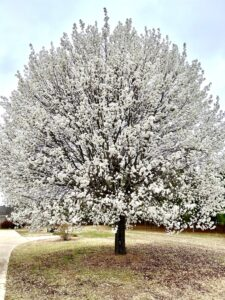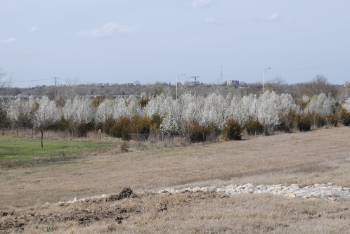How Beauty Became a Beast

The Ornamental Pear was the king of the spring-blooming trees with its beautiful white blooms, glossy green foliage during the summer, and purple fall color. Unfortunately, this "King of Spring" eventually became an invasive nightmare and joined a group of landscape favorites that have turned into plant bullies. How could this happen, and why can we still purchase Ornamental Pears? Let's find out.
The original Ornamental Pear was a variety that went by the name of "Bradford," while it had beautiful but smelly flowers, the tree was fruitless. Most people willingly overlooked the slightly unpleasant flower smell for the blooms. As the trees grew, it became apparent that the tree's branching structure caused it to break under wind and other storms, so the hybridizers began to develop varieties with stronger branch structures. This is where the issue started; pear trees need another variety of pear to cross-pollinate to produce fruit. As new varieties appeared on the market and were planted, the once fruitless Ornamental Pear developed small marble-sized pears. These pears are simply a mess to clean up for homeowners, but birds love them and happily spread the seeds throughout the area.
The pears that come up from the seeds have thorns and are prolific bloomers that start producing fruit at a young age, which has further acerbated the issue, leading to the Ornamental Pear tree being listed as an invasive species in several states plus a plague of baby pears spreading in locations they weren't planted. This is, unfortunately, how the "King of Spring" turned from a spring beauty into a nightmare of a beast, joining the bush honeysuckle, Japanese Barberry, and, in some states, the burning bush as an invasive species.
One of the best characteristics of the Ornamental Pear was that it was a tough tree that could withstand various soil conditions and thrive. Those formerly desirable characteristics make it a demanding customer to control now that it has escaped. The best control will be found in cutting or mowing the small pear trees and treating the stumps or spraying small trees with a combination of glyphosate and triclopyr. If the pears are in a pasture setting, burning can help set them back; however, with their deep root system and ability to sucker, they will return with a vengeance, so additional control measures will need to be taken. Some areas offer a program to provide a new tree if you can bring proof you have cut it down.
various soil conditions and thrive. Those formerly desirable characteristics make it a demanding customer to control now that it has escaped. The best control will be found in cutting or mowing the small pear trees and treating the stumps or spraying small trees with a combination of glyphosate and triclopyr. If the pears are in a pasture setting, burning can help set them back; however, with their deep root system and ability to sucker, they will return with a vengeance, so additional control measures will need to be taken. Some areas offer a program to provide a new tree if you can bring proof you have cut it down.
Don't choose an Ornamental Pear if you want a spring-blooming tree to include in your landscape. Several alternatives have far fewer issues and still provide a beautiful spring color. One of our native trees, the Redbud, has attractive purple blooms in the spring and is adapted to various conditions. It can grow from seed; however, they are easy to remove and control. The flowering dogwood is another native small tree/large shrub that can be planted as an alternative. The beautiful white blooms transition to excellent foliage that turns red in the fall. Another option is the Flowering Crabapple, which comes in various bloom colors, sizes, shapes, and leaf colors. This beautiful tree is disease-resistant, and you can find a crabapple in almost any location with many options. The downside is that some varieties have small "apples" that can leave a mess. In our area, a Magnolia tree is also an option for a replacement tree with gorgeous spring blooms. Several varieties have different bloom colors depending on the size and shape of the plant you want.
The Ornamental Pear is still a beautiful tree every spring and fall; however, its invasive issues coupled with a weak branching structure have made it a plant that I cannot recommend anyone plant. At this time, you can still purchase these trees because the state has not placed a ban on them. There are a variety of alternatives that are overall better trees. I won't say you have to remove the Ornamental Pear if you already have one planted, but I would start to work on an exit strategy because it will need to be removed sooner or later. Unfortunately, these trees are still available for sale across the state but should not be planted in our area.

Have questions? Contact our office where our Horticulture Extension Agent will assist you with questions.
Phone: (316) 321-9660
Email: callae@ksu.edu